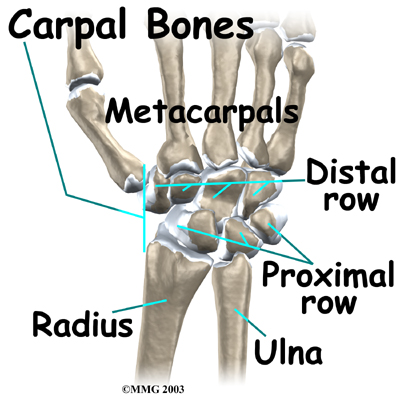The wrist is the name usually given to the eight carpal bones (the lunate, scaphoid, triquetrum, pisiform, trapezium, capitate, hamate and trapezoid carpals) that form the part of the hand closest to the forearm, and the joints that they form with each other and the bones of the forearm and hand. At  The scaphoid, lunate, pisiform and triquetrum carpals articulate (connect) directly with the radius, whereas the other carpal bones are slightly more distal to (further from) the wrist joint. The proximal (closest to the body) parts of the five metacarpals are often included as anatomical components of the wrist.
The scaphoid, lunate, pisiform and triquetrum carpals articulate (connect) directly with the radius, whereas the other carpal bones are slightly more distal to (further from) the wrist joint. The proximal (closest to the body) parts of the five metacarpals are often included as anatomical components of the wrist.
As we all know from experience, a wide range of movement is possible at the wrist, and the radiocarpal joint allows for flexion (bending) extension (straightening), some hyperextension (bending back) abduction (movement away from the body) adduction (movement towards the body) and circumduction (circular movement of the hand from the wrist). If this range of motion if painful you may want to contact a CHIROPRACTIC DOCTOR or one who can provide chiropractic care.
Although the ulna is larger than the radius, it tapers towards the wrist and becomes narrower. Here, at the end of the forearm, the head of the radius connects with the radial notch of the ulna to form the radioulnar joint. This is separated from the radiocarpal joint by the articular disc and allows for supination and pronation movements of the hand (rotating the palm of the hand to face-up and face-down positions respectively). Both the radiocarpal and radioulnar joints are synovial joints, the radiocarpal being a condyloid (or ellipsoid) joint whereas the radioulnar is
a pivot joint. The midcarpal joint occurs between the carpals most proximal to the wrist and those more distal. Between the carpal bones in each row (proximal or distal) are a series of intercarpal joints. These are a combination of synovial planar (sliding) and saddle joints, which allow a degree of movement in the lower hand, including flexion (bending toward the palm) and extension (straightening toward the back of the hand).
Each bone of the wrist is connected to its neighbors by one or more ligaments. Since there are a total of fifteen bones comprising the various wrist joints (the radius, ulna, eight carpals and five metacarpals), this gives rise to a complex arrangement of wrist ligaments. Two of the largest of these are the medial (ulnar) collateral ligament and lateral (radial) collateral ligament. The lateral collateral ligament connects the radius across the wrist to the scaphoid carpal, and the medial collateral ligament attaches the end of ulna to the triquetrum and pisiform carpals.
